Pellet smoker recipes are a game-changer for anyone who loves the smoky, rich flavors of barbecue but wants a simpler, more efficient way to cook. A pellet smoker combines the precision of modern technology with the traditional art of smoking, allowing you to craft mouthwatering dishes with ease. From tender briskets to perfectly smoked ribs, chicken wings, and even vegetables, the possibilities are endless.
Using wood pellets like hickory, applewood, or cherrywood infuses your food with unique, natural flavors that elevate every meal. Whether you’re a beginner experimenting with your first recipes or a seasoned pit-master looking to perfect your craft, pellet smokers make it easy to achieve consistent, delicious results.
In this blog, we’ll explore five must-try pellet smoker recipes that will transform your next BBQ into an unforgettable feast. Get ready to unlock the secrets to smoky perfection.
Table of Contents
Smoked Brisket Recipe
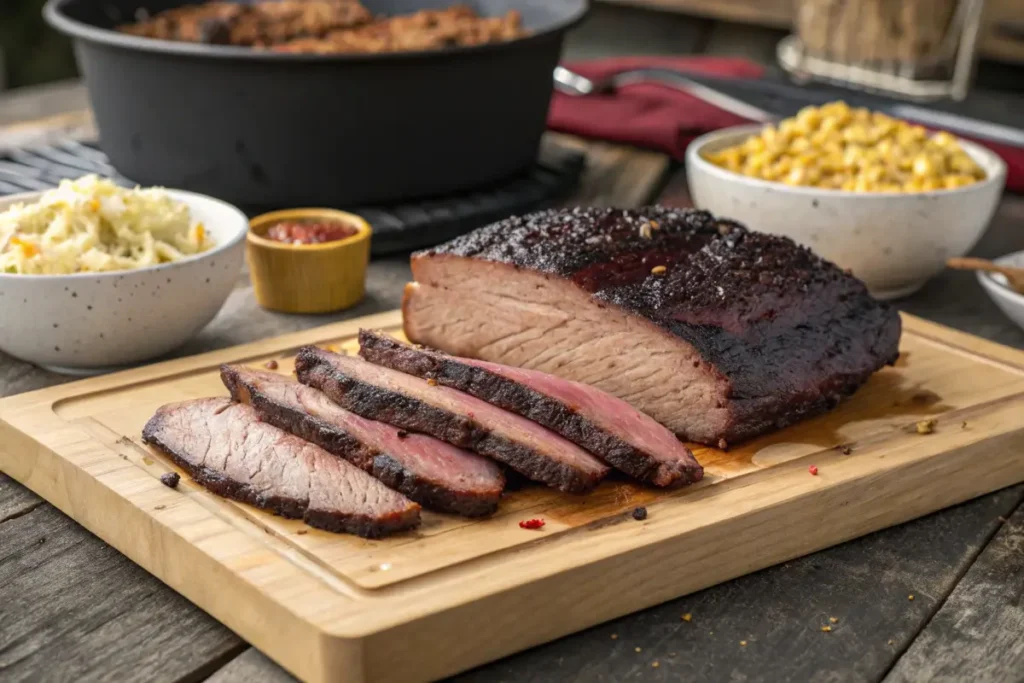
Ingredients for the Perfect Smoked Brisket
Creating the perfect smoked brisket begins with selecting the right ingredients. When working with pellet smoker recipes, the key to success lies in combining high-quality meat with carefully chosen seasonings and wood pellets to enhance the flavor.
- The Brisket: Start with a well-marbled brisket, as the fat content ensures tenderness and flavor. Look for a brisket that is USDA Choice or higher for the best results.
- Seasonings and Rubs: A flavorful rub is essential for smoked brisket. Use a combination of kosher salt, black pepper, garlic powder, paprika, and a touch of cayenne for a balanced taste. Some pellet smoker recipes recommend adding brown sugar for a hint of sweetness that caramelizes beautifully during smoking.
- Marinade or Brine (Optional): While not always necessary, marinating or brining the brisket overnight can add depth to the flavor and help the meat retain moisture during the smoking process.
- Wood Pellets: The type of wood pellets you choose can dramatically impact the final flavor. For brisket, popular options include hickory for a robust, smoky taste or oak for a milder, more balanced smoke. Pellet smoker recipes often suggest mixing woods like hickory and cherry for a unique flavor profile.
- Liquid for Moisture: Keep a spray bottle handy with a mix of apple cider vinegar or even beef broth. Spritzing the brisket periodically while smoking helps maintain moisture and adds a subtle layer of flavor.
Preparing the Brisket for Smoking
Preparing the brisket is one of the most important steps to ensure your pellet smoker recipes turn out flavorful and tender. Start by selecting a high-quality brisket, preferably with good marbling. The fat content in the brisket plays a crucial role in keeping the meat juicy and infusing it with flavor during the smoking process.
Trimming the Brisket
Begin by trimming any excess fat from the brisket. While some fat is essential for flavor, too much can result in a greasy texture. Aim for a quarter-inch fat cap to protect the meat during smoking. A well-trimmed brisket helps your seasoning penetrate better and ensures even cooking, which is key to mastering pellet smoker recipes.
Applying the Rub or Marinade
Season the brisket generously with a dry rub or marinade. Many pellet smoker recipes recommend a mix of salt, pepper, paprika, garlic powder, and brown sugar for a balanced flavor. For enhanced taste, allow the rub to sit on the brisket for at least a few hours, or preferably overnight, in the refrigerator. This resting period allows the seasoning to penetrate deeply, ensuring every bite is flavorful.
Letting the Brisket Reach Room Temperature
Before placing the brisket in the smoker, let it come to room temperature. This step ensures even cooking and prevents the meat from being shocked by the heat. Consistent temperature control is a hallmark of successful pellet smoker recipes, and starting with a room-temperature brisket makes it easier to achieve the perfect smoke.
Preparing the Pellet Smoker
Set up your pellet smoker with your choice of wood pellets, such as hickory for a robust flavor or applewood for a sweeter, milder taste. Preheat the smoker to your desired temperature—usually between 225°F and 250°F for brisket. Proper preparation of both the brisket and the smoker ensures that your pellet smoker recipes will deliver optimal results.
Smoking Process and Tips
The smoking process is the heart of creating flavorful dishes with your pellet smoker. Following a few essential tips can help you achieve perfect results while making the most out of your pellet smoker recipes. Here’s how to ensure a seamless smoking experience:
- Set the Right Temperature
Consistency is key when smoking. Pellet smokers are designed to maintain steady temperatures, but it’s essential to set the right temperature based on your recipe. For meats like brisket or ribs, smoking at a low and slow temperature, around 225°F to 250°F, allows the flavors to develop fully. For faster recipes, like chicken wings or vegetables, a slightly higher temperature can be more effective. - Use the Appropriate Wood Pellets
The choice of wood pellets has a significant impact on the flavor of your pellet smoker recipes. For strong, smoky flavors, hickory or mesquite pellets work well. If you’re aiming for a milder, sweeter taste, try applewood, cherrywood, or maple. Always use high-quality pellets to avoid uneven burning or excess ash. - Prepare the Smoker Correctly
Before starting, preheat your pellet smoker to the desired temperature. Make sure to clean the grates and empty any leftover ash from previous uses. Proper preparation ensures your pellet smoker recipes come out tasting fresh and perfectly cooked. - Monitor Internal Temperatures
While your smoker maintains an even external temperature, monitoring the internal temperature of your food is equally important. Use a meat thermometer to ensure your brisket, ribs, or chicken reaches the recommended temperature for doneness and safety. - Experiment With Smoking Techniques
To elevate your pellet smoker recipes, experiment with techniques like wrapping meat in foil during the final cooking stages to lock in moisture. This is particularly effective for recipes like brisket or ribs, where a tender, juicy texture is desired. - Maintain Proper Airflow
Ensure there’s adequate airflow within the smoker. Avoid overcrowding the grates, as proper circulation allows smoke to evenly coat the food, enhancing the flavors of your recipes.
Serving Suggestions
When it comes to serving dishes made using pellet smoker recipes, the possibilities are as versatile as the smoker itself. Smoked meats and vegetables pair beautifully with a wide variety of sides, sauces, and garnishes that enhance their flavor and presentation. Here are some ideas to make your pellet smoker creations the star of any meal:
Perfect Side Dishes
Pellet smoker recipes are often rich and flavorful, so pairing them with complementary side dishes is key. Consider serving smoked brisket or ribs with creamy coleslaw, buttery cornbread, or tangy baked beans. For a lighter option, smoked salmon can be paired with roasted asparagus or a crisp green salad. Smoked vegetables, such as zucchini or bell peppers, shine when accompanied by a grain like quinoa or wild rice.
Delicious Sauces and Glazes
The right sauce can elevate your pellet smoker recipes to new heights. Sweet and smoky BBQ sauce is a classic choice for brisket, ribs, or pulled pork. For chicken wings, offer a variety of dipping sauces such as ranch, buffalo, or honey mustard. When serving smoked salmon, a drizzle of lemon-dill butter or a creamy herb sauce adds a gourmet touch.
Creative Garnishes
Don’t forget about garnishes! Fresh herbs like parsley, cilantro, or chives can add a pop of color and freshness to your smoked dishes. Sprinkle sesame seeds or crushed nuts over smoked vegetables for added texture and flavor. For smoked meats, a side of pickles or jalapeños can provide a tangy contrast.
Beverage Pairings
To round out your meal, pair your pellet smoker recipes with the perfect beverage. A cold beer or a glass of smoky red wine complements the robust flavors of smoked meats, while a refreshing iced tea or sparkling water works well with lighter dishes like smoked fish or vegetables.
Smoked Ribs Recipe
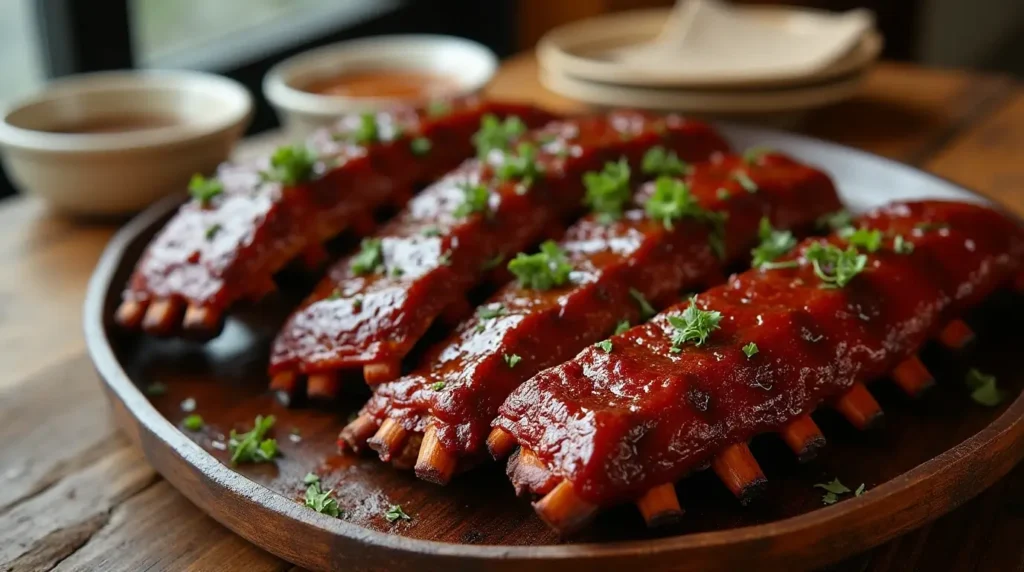
Choosing the Best Ribs for Smoking
When it comes to crafting irresistible ribs using pellet smoker recipes, selecting the right type of ribs is crucial. There are two main types of pork ribs to consider: baby back ribs and spare ribs. Each has its unique characteristics, and your choice will depend on your taste preferences and cooking style.
Baby Back Ribs
Baby back ribs are cut from the upper part of the ribcage, near the backbone, and are typically smaller and leaner than spare ribs. They are prized for their tender texture and slightly sweet flavor. If you prefer ribs that cook quickly and have a more delicate bite, baby back ribs are an excellent choice for your pellet smoker recipes.
Spare Ribs
Spare ribs, on the other hand, come from the lower part of the ribcage and have more meat and fat content. This extra fat makes them incredibly flavorful, especially when smoked low and slow. They take a bit longer to cook but are well worth the effort for their rich, savory taste. Spare ribs are ideal for those who enjoy heartier, juicier ribs with a smoky finish.
Rib Quality and Preparation
When selecting ribs for your pellet smoker recipes, look for racks with even marbling and minimal surface fat. High-quality ribs should have a bright pink color and firm texture. Avoid racks with excessive bone exposure or uneven cuts, as they may cook unevenly.
Before smoking, it’s essential to remove the silverskin—a tough membrane on the underside of the ribs. This allows the seasoning and smoke to penetrate the meat more effectively, resulting in flavorful, tender ribs.
Recommended Wood Pellets
The choice of wood pellets plays a significant role in enhancing the flavor of your ribs. For baby back ribs, mild woods like applewood or cherrywood complement their sweetness. For spare ribs, stronger woods like hickory or mesquite add bold, smoky flavors. Experimenting with wood combinations is a great way to customize your pellet smoker recipes to your taste.
Preparing Ribs for the Smoker
Preparing ribs for the smoker is a crucial step in achieving tender, flavorful results that will wow your guests. Whether you’re working with baby back ribs or spare ribs, the preparation process ensures that every bite is infused with the rich, smoky taste that pellet smoker recipes are known for.
Trimming the Ribs
Start by inspecting your ribs for any excess fat or silver skin. Trimming off the silver skin is essential as it can prevent the seasoning from penetrating the meat. Use a sharp knife to carefully remove it, ensuring the surface of the ribs is smooth and ready for seasoning. Proper trimming is a hallmark of great pellet smoker recipes because it allows the smoke and flavors to permeate evenly.
Applying the Dry Rub
A flavorful dry rub is the foundation of delicious smoked ribs. Combine spices like paprika, garlic powder, onion powder, brown sugar, salt, and pepper to create a balanced blend. Generously coat the ribs with the dry rub, ensuring that every inch is covered. Let the ribs sit with the rub for at least an hour, or better yet, refrigerate them overnight. This step helps the flavors penetrate deep into the meat, a key element in successful pellet smoker recipes.
Letting the Ribs Rest
After applying the dry rub, it’s important to let the ribs rest at room temperature for about 30 minutes before placing them in the smoker. This allows the rub to meld with the meat and ensures the ribs cook evenly once they hit the smoker. Resting the ribs also gives you time to prepare the smoker and get it to the ideal temperature.
Choosing the Right Wood Pellets
For ribs, wood pellets like applewood, cherrywood, or hickory work exceptionally well. Applewood adds a sweet, mild flavor, while hickory offers a stronger, traditional smoky taste. Selecting the right wood is an integral part of perfecting your pellet smoker recipes, as it can dramatically enhance the flavor of the meat.
Smoking Ribs Low and Slow
One of the secrets to creating delicious ribs using pellet smoker recipes is mastering the “low and slow” smoking technique. For more inspiration, check out this recipe for a flavorful chipotle steak, which is perfect for those who enjoy bold, smoky flavors.
This method ensures that the ribs cook evenly, remain juicy, and develop that perfect smoky flavor that makes every bite unforgettable.
Temperature and Timing
To achieve tender and flavorful ribs, set your pellet smoker to a consistent temperature of 225°F to 250°F. This low heat allows the smoke to penetrate the meat gradually, breaking down connective tissues for a melt-in-your-mouth texture. For most rib recipes, the cooking time will range from 5 to 6 hours, depending on the type and thickness of the ribs.
The 3-2-1 Method
A popular approach in many pellet smoker recipes is the 3-2-1 method:
- Three hours of initial smoking: Place the seasoned ribs directly on the smoker grates and let them absorb the smoky flavor. Use wood pellets like applewood for a mild sweetness or hickory for a more robust taste.
- Two hours wrapped in foil: Wrap the ribs tightly in aluminum foil with a bit of liquid, such as apple juice, to keep them moist and tender as they continue to cook.
- One hour unwrapped with sauce: Unwrap the ribs for the final hour to allow the bark to firm up and apply a layer of BBQ sauce for a sticky, flavorful glaze.
Monitoring and Adjusting
Using a meat thermometer is essential to perfecting pellet smoker recipes. For ribs, aim for an internal temperature of around 190°F to 203°F for optimal tenderness. Check periodically to ensure the ribs are cooking evenly, and adjust the smoker temperature slightly if needed. Avoid opening the smoker too often, as this can cause fluctuations in heat and smoke levels.
Enhancing the Smoky Flavor
To amplify the flavor, experiment with different wood pellet blends, such as cherrywood for a subtle fruitiness or mesquite for a bold, smoky punch. The choice of pellets plays a significant role in how your ribs will taste, making it a key factor in the success of your pellet smoker recipes.
Glazing and Serving Smoked Ribs
One of the highlights of smoked ribs is the finishing glaze that adds a layer of irresistible flavor and a glossy, caramelized appearance. For the best results, choose a glaze that complements the smoky undertones of your ribs. Popular options include barbecue sauce, honey-based glazes, or fruit-infused sauces like apple or cherry. These glazes not only enhance the taste but also help lock in the moisture, ensuring your ribs are tender and juicy.
To glaze your ribs effectively, apply the sauce during the last 30 minutes of smoking. Brush a generous layer onto both sides of the ribs and allow the heat to caramelize the sugars in the glaze, creating a slightly sticky, flavorful crust. You can repeat this process once or twice for a more intense flavor, but be careful not to overdo it, as too much glaze can overpower the smoky profile of your ribs.
When serving smoked ribs from your pellet smoker recipes, presentation matters just as much as flavor. Slice the ribs between each bone for easy serving and arrange them neatly on a platter. Garnish with freshly chopped herbs like parsley or cilantro for a pop of color. Pair your smoked ribs with classic BBQ sides such as coleslaw, baked beans, or corn on the cob to round out the meal.
Smoked Chicken Wings Recipe
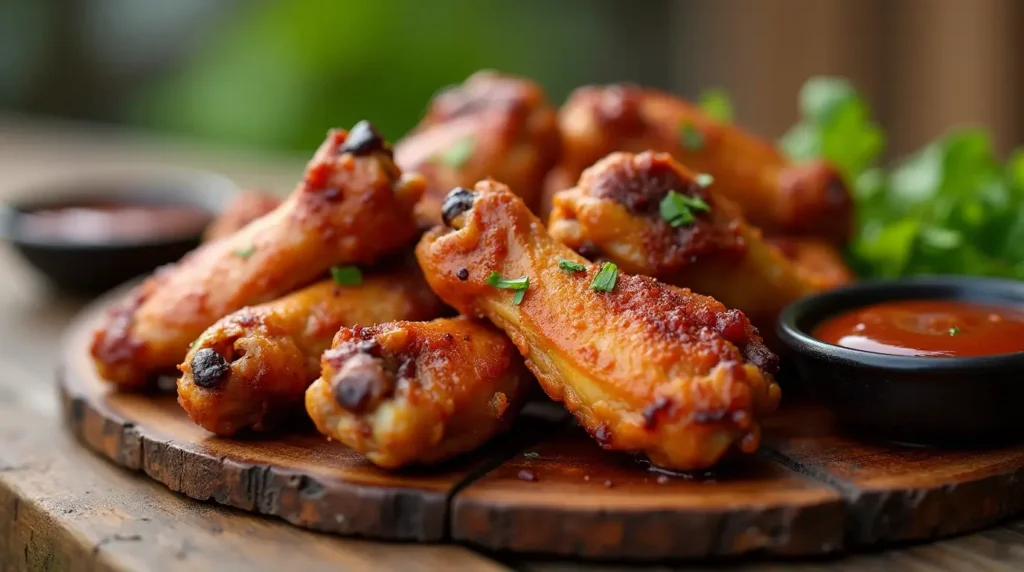
Ingredients and Marinade Tips
When it comes to crafting the perfect smoked chicken wings, the ingredients and marinade play a crucial role in enhancing flavor and tenderness. Using a pellet smoker allows the natural smoky essence to infuse your chicken wings, but the right combination of seasonings and marinade will take your recipe to the next level.
Essential Ingredients for Smoked Chicken Wings
- Chicken Wings: Opt for fresh, high-quality wings. You can choose between whole wings or pre-cut drumettes and flats based on your preference.
- Dry Rub: A flavorful dry rub is key. Common ingredients include paprika, garlic powder, onion powder, cayenne pepper, salt, and black pepper. For a touch of sweetness, add brown sugar.
- Marinade: Marinades are optional but highly recommended for enhancing moisture and adding depth of flavor. Popular marinade ingredients include olive oil, soy sauce, lemon juice, honey, and herbs like thyme or rosemary.
- Wood Pellets: Choose wood pellets that complement chicken, such as applewood, cherrywood, or pecan, to add a subtle sweetness to your smoked wings.
Tips for Preparing the Marinade
- Balance the Flavors: When creating your marinade, aim for a balance of salt, acid, sweetness, and aromatics. For instance, a marinade with soy sauce (salt), lemon juice (acid), honey (sweetness), and garlic (aromatics) will provide a well-rounded flavor profile.
- Allow Time for Marination: Let the chicken wings marinate for at least 2-4 hours, or ideally overnight, to allow the flavors to fully penetrate the meat. Place the wings in a resealable bag or a covered container and refrigerate during this process.
- Pat Dry Before Smoking: After marinating, pat the wings dry with a paper towel to ensure a crispier skin during smoking.
Enhancing Flavor with Pellet Smoker Recipes
Using your pellet smoker adds an extra layer of flavor to your chicken wings that can’t be achieved with traditional cooking methods. The marinade combined with the wood pellet smoke creates a depth of flavor that makes your wings stand out. Experimenting with different wood pellet types and seasoning combinations allows you to personalize your dish while keeping it consistent with the essence of pellet smoker recipes.
Prepping Chicken Wings for Smoking
Preparing chicken wings for smoking is a crucial step to ensure they turn out flavorful, juicy, and perfectly cooked. Whether you’re new to pellet smoker recipes or an experienced BBQ enthusiast, getting this step right makes all the difference.
Start by selecting high-quality, fresh chicken wings. Look for wings that are uniform in size to ensure even cooking. Once you have your wings, rinse them thoroughly under cold water and pat them dry with paper towels. Dry wings allow the seasoning to stick better and help achieve a crispier skin when smoked.
Next, focus on seasoning. For pellet smoker recipes, a good dry rub can elevate your chicken wings to the next level. Create a blend of salt, black pepper, garlic powder, paprika, and a touch of cayenne for some heat. For an extra kick, you can add your favorite spices to customize the flavor. Coat the wings generously with the dry rub, making sure every surface is evenly covered.
If you prefer marinated wings, prepare your marinade ahead of time and let the wings soak in it for at least 2-4 hours. Marinating not only enhances the flavor but also helps tenderize the meat. Popular marinade ingredients include soy sauce, honey, lime juice, and herbs.
Before placing the wings in the smoker, let them sit at room temperature for 15-20 minutes. This helps the wings cook more evenly. Additionally, preheat your pellet smoker to the desired temperature, usually around 225°F for a low and slow cook, or 275°F if you prefer crispier skin.
Smoking and Grilling Process
The smoking and grilling process for chicken wings is where the magic happens. Achieving perfectly smoked chicken wings with your pellet smoker recipes starts with understanding the right temperature and timing. Begin by preheating your pellet smoker to 225°F, ensuring the smoker is set up with your preferred wood pellets, such as hickory or applewood, for a flavorful infusion.
Place the seasoned chicken wings evenly on the smoker grates, leaving enough space between each piece for proper airflow. This helps the wings cook evenly and allows the smoke to surround them fully, enhancing the smoky flavor. For pellet smoker recipes like this, maintaining a consistent temperature is key. Use a thermometer to monitor the internal smoker temperature throughout the process.
Smoke the wings for approximately 60–90 minutes, or until they reach an internal temperature of 165°F. This ensures the chicken is fully cooked while still juicy. To achieve a crispy skin, increase the temperature of your pellet smoker to 375°F for the last 10–15 minutes. This grilling step gives the wings a delightful crunch that complements the tender, smoky interior.
During the smoking and grilling process, avoid opening the smoker too frequently, as this can cause heat loss and disrupt the cooking time. Once done, let the wings rest for a few minutes before serving. This allows the juices to redistribute, making them even more flavorful. These steps are essential for mastering pellet smoker recipes and delivering the best smoked chicken wings every time.
Dipping Sauces for Smoked Wings
No platter of smoked wings is complete without the perfect dipping sauces to elevate their flavor. When planning your menu, consider pairing smoked chicken wings with this savory raspberry chipotle sauce. It adds a unique, tangy twist that complements the smoky richness of your wings.
When creating pellet smoker recipes, it’s essential to think about complementary sauces that bring out the smokiness of the wings while adding layers of taste.
Classic BBQ Sauce
A rich and tangy BBQ sauce is a staple for smoked wings. Its combination of sweetness, acidity, and smokiness pairs beautifully with wings prepared using pellet smoker recipes. Opt for a homemade version or choose a high-quality store-bought sauce that emphasizes natural ingredients.
Spicy Buffalo Sauce
For those who love a kick of heat, buffalo sauce is a must-have. Its bold, spicy profile contrasts with the savory, smoked flavor of the wings. Adding a bit of melted butter to the sauce can create a creamier texture, making it a favorite for dipping.
Ranch or Blue Cheese Dressing
These creamy classics are perfect for balancing the smoky richness of pellet smoker recipes. Ranch dressing brings a cool and herby flavor, while blue cheese offers a tangy, slightly sharp bite. Both options enhance the overall taste experience when paired with smoked wings.
Honey Mustard Sauce
Sweet, tangy, and slightly sharp, honey mustard sauce is another fantastic option for smoked wings. Its golden hue and well-rounded flavor make it a popular choice for pellet smoker recipes, especially when serving a crowd with varied tastes.
Asian-Inspired Dipping Sauces
For a unique twist, try sauces like teriyaki glaze, sweet chili sauce, or a soy-ginger dip. These Asian-inspired flavors add a touch of sweetness and umami, perfectly complementing wings smoked to perfection with pellet smoker recipes.
Additional Snack Inspiration
Looking for more snack ideas to accompany your smoked chicken wings? Check out Chicken Fries: 10 Ultimate Tips for the Perfect Snack Experience for another crowd-pleasing option to serve at your next BBQ gathering. These crispy bites can be a fun complement to your wings and dipping sauces.
Smoked Salmon Recipe
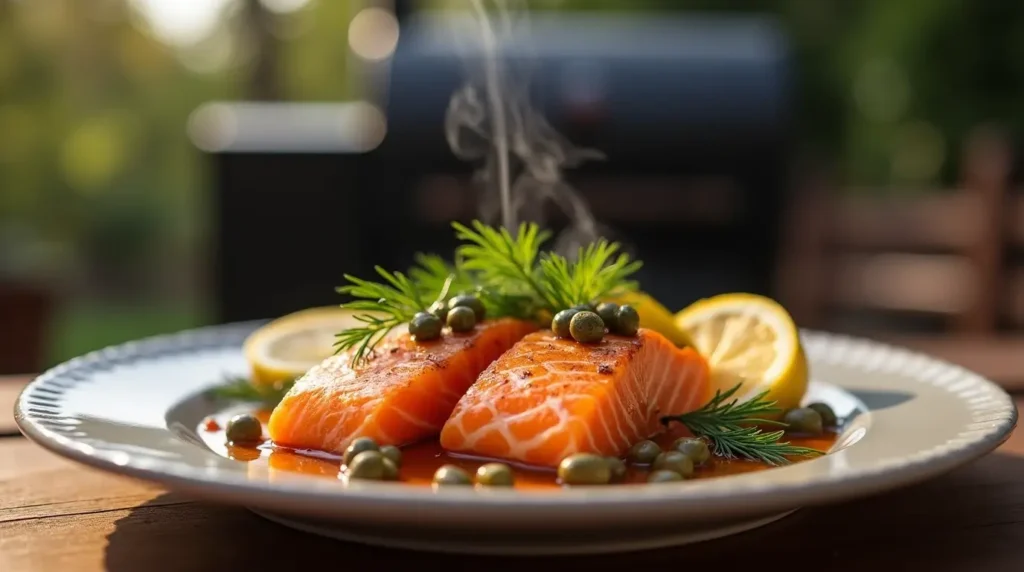
Selecting the Right Salmon and Pellets
Choosing the right salmon and wood pellets is essential for creating flavorful and successful dishes with pellet smoker recipes. When selecting salmon, opt for high-quality, fresh cuts to ensure the best texture and taste. Look for fillets with a bright, vibrant color and firm flesh. Wild-caught salmon, such as sockeye or king salmon, is often preferred for its rich flavor, but farm-raised options like Atlantic salmon can also work well, especially for those on a budget.
In addition to selecting the perfect salmon, the choice of wood pellets can significantly impact the overall flavor of your dish. For fish, lighter woods such as alder, cherrywood, or applewood are ideal because they provide a subtle smokiness that complements the delicate flavor of salmon without overpowering it. Avoid stronger woods like mesquite or hickory, which are better suited for red meats and may mask the natural taste of salmon.
Preparing and Seasoning Salmon
Preparing and seasoning salmon is a crucial step in creating flavorful and tender dishes with pellet smoker recipes. Start by selecting high-quality salmon fillets or steaks. Fresh salmon with a firm texture and vibrant color ensures the best results. Wild-caught salmon varieties, such as sockeye or king salmon, are often preferred for their rich flavor and healthy omega-3 content.
Begin by patting the salmon dry with paper towels to remove excess moisture. This helps the seasoning adhere better and promotes even cooking. For seasoning, you can use a simple salt and pepper mix, or get creative with a blend of spices. Popular choices include garlic powder, paprika, dill, and a touch of cayenne for heat. If you prefer a slightly sweet flavor, brown sugar can be added to your seasoning blend, balancing the smoky taste of your pellet smoker recipes perfectly.
For an extra layer of flavor, consider marinating the salmon. A marinade with olive oil, lemon juice, soy sauce, and fresh herbs not only enhances the taste but also keeps the salmon moist during smoking. Allow the fish to marinate for 30 minutes to an hour in the refrigerator, but avoid over-marinating as the acidity can break down the salmon’s texture.
Smoking the Salmon Perfectly
Smoking salmon is an art that requires the right balance of temperature, timing, and technique. When preparing salmon for your pellet smoker recipes, it’s important to ensure consistent heat and smoke to achieve that tender, flaky texture and rich smoky flavor. Here’s how you can smoke salmon perfectly every time:
- Set the Temperature Right
Start by preheating your pellet smoker to 225°F. This temperature is ideal for cooking salmon slowly, allowing the smoke to infuse the fish while keeping it moist. A steady and moderate heat ensures the salmon cooks evenly without drying out, making it a staple in pellet smoker recipes. - Use the Right Wood Pellets
Choosing the right wood pellets can greatly influence the flavor of your smoked salmon. For pellet smoker recipes featuring fish, lighter wood options like alder, cherrywood, or applewood work best. These provide a subtle smoky aroma that complements the natural flavor of salmon without overpowering it. - Monitor the Internal Temperature
The key to perfectly smoked salmon is monitoring its internal temperature. Use a meat thermometer to ensure the thickest part of the salmon reaches 145°F. This guarantees the fish is cooked through while preserving its delicate texture, a hallmark of successful pellet smoker recipes. - Timing is Everything
Smoking salmon typically takes about 2 to 3 hours, depending on the thickness of the fillet. Thicker cuts will take longer, so patience is crucial. During this time, resist the urge to open the smoker frequently, as this can cause temperature fluctuations. - Enhance the Smoke Flavor
For deeper flavor, consider spritzing the salmon with a mixture of apple juice and water every 30 minutes. This keeps the surface moist and adds a hint of sweetness, enhancing the overall profile of your pellet smoker recipes. - Let It Rest Before Serving
Once the salmon is smoked to perfection, let it rest for about 5 to 10 minutes before serving. This allows the juices to redistribute throughout the fillet, making it even more flavorful and satisfying.
Side Dishes to Pair with Smoked Salmon
When creating a meal featuring smoked salmon, pairing it with the right side dishes is essential to complement its smoky, savory flavors. The versatility of smoked salmon makes it an excellent choice for a variety of sides that elevate the overall dining experience. Whether you’re preparing smoked salmon as part of your pellet smoker recipes, or serving it as a standalone dish, here are some delicious and well-matched side dishes to consider:
- Roasted Vegetables
Roasted vegetables like asparagus, zucchini, or brussels sprouts are a natural pairing for smoked salmon. Toss them with olive oil, a sprinkle of salt, and a dash of pepper before roasting to bring out their sweetness and provide a delightful contrast to the smoky salmon. These vegetables can even be prepared as part of your pellet smoker recipes for a consistent smoky flavor throughout the meal. - Creamy Pasta
A creamy pasta dish, such as fettuccine Alfredo or a lemon butter pasta, works beautifully with smoked salmon. The richness of the sauce enhances the delicate, smoky undertones of the salmon while creating a satisfying and indulgent meal. Consider adding fresh herbs like dill or parsley for a burst of freshness. - Potato Dishes
Smoked salmon pairs wonderfully with hearty potato-based dishes. Options like roasted garlic mashed potatoes, crispy potato wedges, or a light potato salad add a comforting element to the meal. For a unique twist, you can even use the smoker to bake potatoes, incorporating them directly into your pellet smoker recipes. - Fresh Green Salads
A simple green salad with a tangy vinaigrette provides a refreshing counterbalance to the richness of smoked salmon. Include ingredients like mixed greens, cherry tomatoes, cucumbers, and a sprinkling of capers for an extra punch of flavor. The bright acidity of the dressing helps to cut through the smokiness of the salmon. - Grain-Based Sides
Grain-based sides such as quinoa, wild rice, or barley salads make excellent companions for smoked salmon. Toss these grains with roasted vegetables, a citrus dressing, or fresh herbs to create a wholesome and flavorful side dish. These grains also absorb the juices from the salmon, enhancing their taste. - Smoked Bread or Rolls
Complement your smoked salmon with bread or rolls that have been lightly smoked in the pellet smoker. The smoky aroma of the bread ties the meal together and adds an artisanal touch to your table. Pair it with cream cheese or a dill spread for added indulgence.
For those who want to preserve leftover smoked salmon, check out Can You Freeze Smoked Salmon? 4 Easy Ways to Preserve Quality. This guide provides helpful tips to maintain the quality of your smoked salmon for future meals.
Smoked Vegetables and Side Dishes
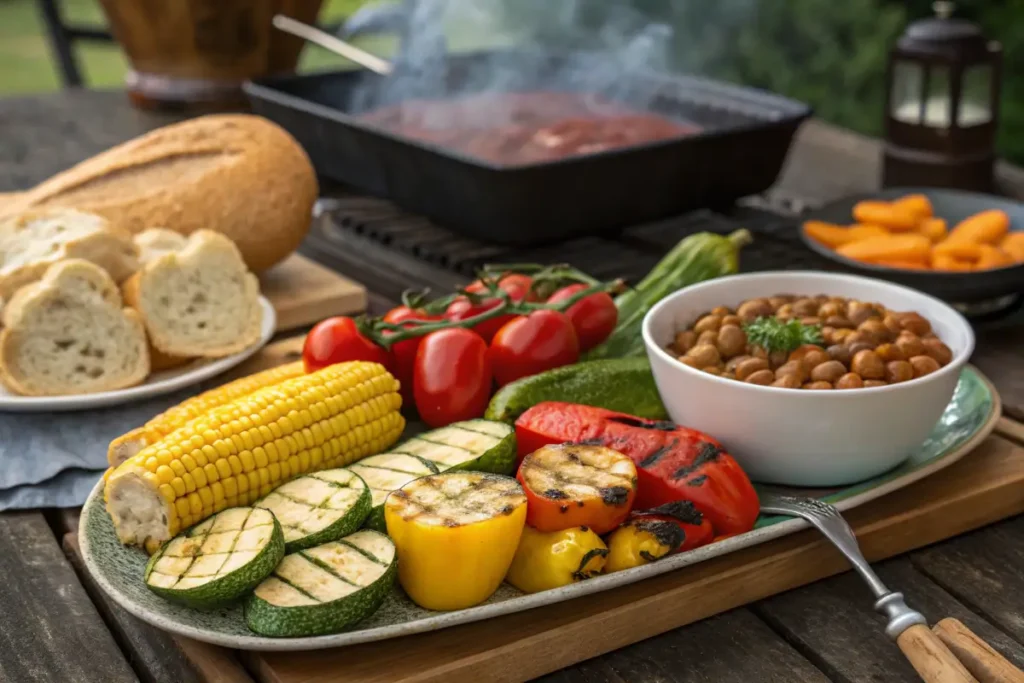
Best Vegetables for Smoking
Vegetables are often an underrated part of pellet smoker recipes, but they can be just as flavorful and satisfying as smoked meats. Smoking vegetables brings out their natural sweetness and imparts a smoky depth that makes them a perfect addition to any BBQ meal. Plus, smoking vegetables is incredibly versatile—you can experiment with different types to suit your taste or complement your main dishes.
Some of the best vegetables for smoking include:
- Bell Peppers: Their natural sweetness intensifies when smoked, and they make an excellent side or topping for smoked meats. Try using a mix of red, yellow, and green bell peppers for a colorful addition to your plate.
- Zucchini and Squash: These vegetables soak up smoke beautifully and have a tender texture when cooked. Slice them into thick rounds or long strips to prevent them from falling apart.
- Corn on the Cob: Smoked corn is a classic choice for pellet smoker recipes. Leave the husks on for a more tender texture, or peel them back for charred, smoky kernels.
- Mushrooms: Portobello mushrooms, in particular, are hearty and absorb smoke well. They can even serve as a meat substitute for vegetarian guests.
- Carrots and Root Vegetables: Smoking brings out their natural sweetness while adding a smoky edge. Slice them into chunks or strips for even cooking.
- Asparagus: This delicate vegetable cooks quickly on a smoker and pairs well with smoked salmon or chicken.
How to Prep Vegetables for Smoking
Preparing vegetables for smoking is a crucial step to ensure they turn out flavorful, tender, and perfectly cooked. For those exploring pellet smoker recipes, adding smoked vegetables is an excellent way to complement your main dishes while maximizing the versatility of your smoker.
Choose the Right Vegetables
Start by selecting fresh vegetables that are well-suited for smoking. Popular choices include bell peppers, zucchini, asparagus, mushrooms, and corn. Hardy vegetables like carrots and sweet potatoes also work well and can withstand longer cooking times. For best results, choose vegetables of similar size to ensure even cooking.
Clean and Cut Properly
Thoroughly wash your vegetables under running water to remove any dirt or debris. Peel, trim, and cut them into uniform pieces, as this helps them cook evenly and absorb smoke flavor consistently. For example, slice zucchini into thick rounds or cut bell peppers into wide strips. If you’re smoking smaller items like mushrooms, you can leave them whole or halve them for faster cooking.
Season Generously
Seasoning is a vital step when preparing vegetables for pellet smoker recipes. Drizzle your vegetables with olive oil to prevent them from drying out during the smoking process. Then, season them with salt, pepper, and your favorite herbs or spices. For added depth, consider using a BBQ rub or a sprinkle of smoked paprika. This enhances the smoky flavors and makes the vegetables irresistible.
Use Skewers or Grill Baskets
To make handling easier, especially for smaller vegetables, consider using skewers or a grill basket. Skewering vegetables like cherry tomatoes, zucchini, or onion slices keeps them from falling through the grates. A grill basket allows you to toss and turn your vegetables easily without losing any pieces.
Let the Vegetables Rest Before Smoking
After seasoning, let the vegetables rest for 10-15 minutes. This allows the oil and seasonings to fully coat the vegetables, enhancing their flavor when they’re smoked. Resting also helps the vegetables develop a slight surface moisture, which will attract more smoke for a richer taste.
Smoking Vegetables on a Pellet Smoker
Smoking vegetables on a pellet smoker is a fantastic way to add depth and flavor to your meals while showcasing the versatility of pellet smoker recipes. Vegetables absorb smoky flavors beautifully, turning ordinary sides into extraordinary dishes that complement any main course.
Preparing Your Pellet Smoker
Start by preheating your pellet smoker to the appropriate temperature, typically around 225°F to 250°F. Select the wood pellets that best match your desired flavor profile. For vegetables, lighter woods like applewood or cherrywood work well, offering a subtle sweetness that enhances their natural taste. Ensuring your smoker is clean and the hopper is filled with fresh pellets is key to a seamless smoking experience.
Choosing and Prepping Vegetables
When it comes to pellet smoker recipes, not all vegetables are created equal. Some of the best vegetables for smoking include bell peppers, zucchini, mushrooms, corn, onions, and asparagus. Chop them into uniform sizes to ensure even cooking. For a simple yet flavorful preparation, lightly coat the vegetables with olive oil and season with salt, pepper, garlic powder, or your favorite BBQ spice blend. Adding a dash of lemon juice or balsamic vinegar can enhance their flavor even more.
Smoking Techniques for Vegetables
Place the prepared vegetables directly on the smoker grates or use a grill basket to prevent smaller pieces from falling through. Depending on the type of vegetable, smoking times can vary between 30 to 60 minutes. To ensure they cook evenly, arrange the vegetables in a single layer and rotate or toss them halfway through the cooking process.
For those looking to experiment with pellet smoker recipes, try mixing vegetables with different textures and flavors. For example, pairing sweet corn with smoky bell peppers and earthy mushrooms can create a harmonious side dish that’s both visually appealing and delicious.
Tips for Perfectly Smoked Vegetables
Monitor the temperature of your pellet smoker throughout the cooking process to avoid undercooking or burning the vegetables. Taste test as you go to determine your preferred level of smokiness. Once they’re done, remove the vegetables promptly and let them rest for a few minutes to retain their juices. Smoked vegetables pair wonderfully with grilled meats or can be served as a standalone dish.
Creative Side Dishes for a BBQ Feast
No barbecue is complete without the perfect side dishes to complement your main dishes. When planning your pellet smoker recipes, it’s important to think about sides that enhance the smoky flavors and add variety to your meal. Here are some creative and crowd-pleasing ideas for side dishes that pair wonderfully with smoked meats and vegetables:
Smoked Mac and Cheese
One of the most popular additions to any BBQ feast is smoked mac and cheese. If you’re looking for other comforting sides, try this recipe for a brisket sandwich. It’s an excellent way to use leftover brisket while complementing other dishes on your menu.
Using your pellet smoker, you can take this classic comfort food to the next level. Simply prepare your mac and cheese as usual, then place it in the smoker to absorb a rich, smoky flavor. The combination of creamy cheese and a crispy, golden topping is irresistible and pairs perfectly with any pellet smoker recipes you prepare.
Smoked Corn on the Cob
Corn on the cob is a BBQ staple, but smoking it gives it a whole new dimension of flavor. Rub the corn with butter, season it with your favorite spices, and wrap it in foil before placing it in the pellet smoker. The result is tender, juicy corn with a subtle smokiness that complements dishes like smoked ribs or chicken wings.
Baked Beans with a Smoky Twist
Baked beans are another classic side dish that pairs beautifully with pellet smoker recipes. Add a smoky kick by cooking the beans in your pellet smoker alongside your main dishes. Mix in bacon, onions, and barbecue sauce for a rich, savory flavor that perfectly balances the sweetness of the beans.
Smoked Garlic Bread
Garlic bread is a versatile side dish that becomes even better when smoked. Simply butter slices of bread, sprinkle them with garlic and herbs, and smoke them until they’re crispy and golden. The light smoky flavor enhances the richness of pellet smoker recipes like brisket or salmon.
Grilled Veggie Skewers
Vegetables like bell peppers, zucchini, mushrooms, and cherry tomatoes are excellent for smoking. Thread them onto skewers, season them with olive oil, salt, and your favorite spices, and cook them in the pellet smoker. These veggie skewers not only add color to your BBQ spread but also provide a lighter, healthier option for guests.
Wrapping Up Your Pellet Smoker Adventure
As you explore the world of pellet smoker recipes, it’s clear that the possibilities are virtually endless. From tender briskets and smoky ribs to creative side dishes and even desserts, a pellet smoker empowers you to transform simple ingredients into mouthwatering creations. The beauty of using a pellet smoker lies not only in the bold, smoky flavors it imparts but also in the ease and consistency it offers for cooks of all skill levels.
One of the greatest joys of preparing pellet smoker recipes is the ability to customize flavors to suit your preferences. Whether you’re experimenting with different wood pellet types like applewood for a touch of sweetness or mesquite for a bold kick, every recipe becomes a unique experience. Additionally, the versatility of a pellet smoker allows you to prepare entire meals, including appetizers, mains, and sides, all in one convenient device.
Hosting a BBQ with dishes crafted from pellet smoker recipes is sure to leave a lasting impression on your guests. The combination of smoky aromas, rich flavors, and perfectly cooked dishes creates an unforgettable dining experience. Plus, with a little practice, you can master advanced techniques like the 3-2-1 rib method or experimenting with marinades and rubs for unique flavor profiles.
As you wrap up your BBQ feast, don’t forget the importance of presentation and pairing. A well-planned spread featuring smoked meats, vibrant side dishes, and refreshing beverages will elevate your gathering to the next level. And most importantly, enjoy the process! Smoking food with a pellet smoker is as much about the journey as it is about the destination.
So fire up your pellet smoker, try out the recipes in this post, and embrace the delicious world of smoky flavors. Who knows? Your next pellet smoker recipe might just become a new family favorite.

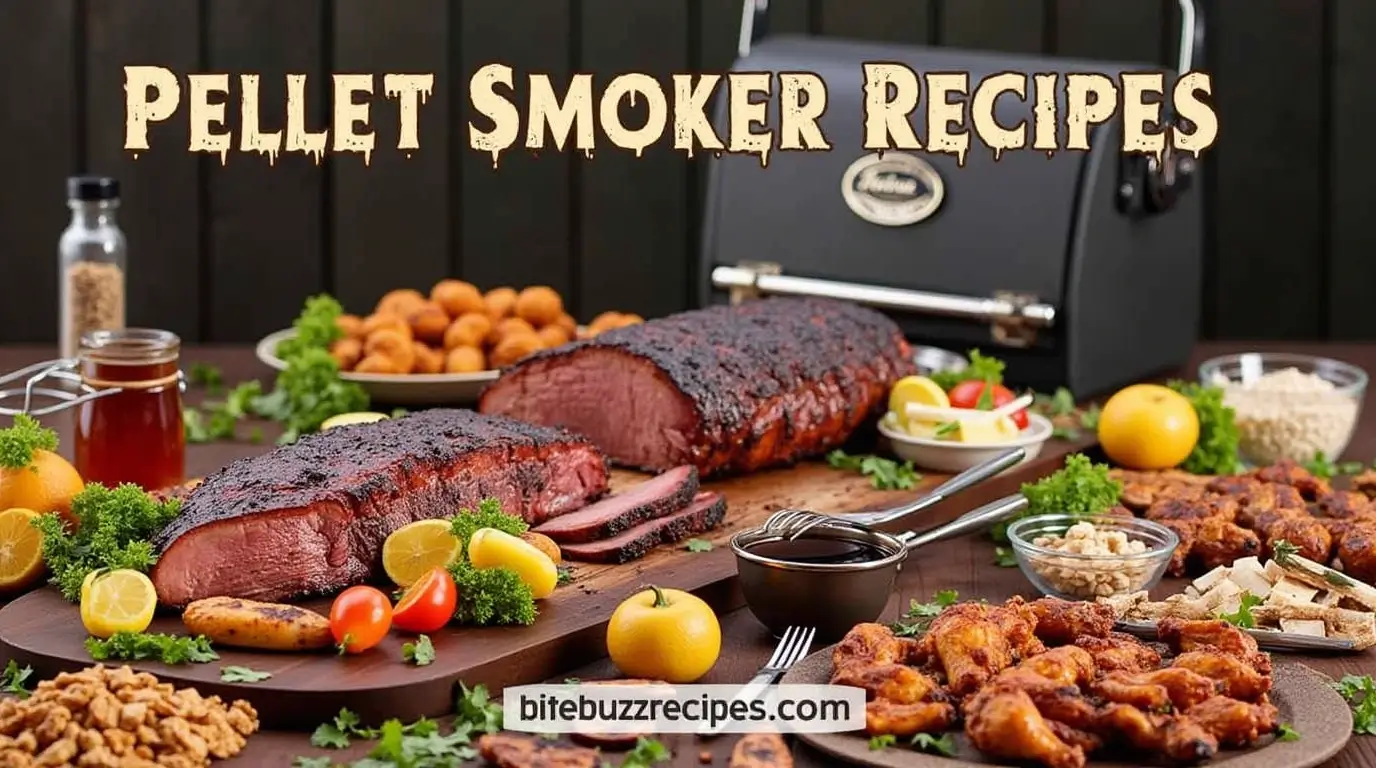
6 thoughts on “Top 5 Pellet Smoker Recipes for a Perfect BBQ”